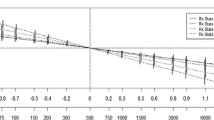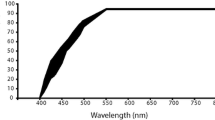Abstract
Background
It is known that binocular function is affected by interocular differences in retinal image size, shape, clarity, and illumination. The present study was performed to systematically examine the effects of interocular differences in retinal illuminance on monocular visual acuity, fusion, and stereopsis.
Methods
Fifty adults with normal binocularity and a best-corrected visual acuity of 20/20 or better were enrolled. We examined best-corrected visual acuity, fusion, and stereoacuity as monocular retinal illuminance was gradually reduced by increasing neutral density filters from 0.2 neutral density (ND; 63% transmission) to 3.0 ND (0.1% transmission) in increments of 0.2 ND. We measured the smallest size of fusion slide by major amblyoscope, and evaluated stereoacuity with the Titmus test and the Lang test.
Results
The best-corrected visual acuity began to decrease significantly when the value of the neutral density filter reached 2.0 ND (1% transmission; p<0.01). The level of fusion decreased significantly when monocular retinal illuminance was reduced to 2.0 ND (p<0.01). Stereoacuity began to decline significantly when the value of the neutral density filter was 1.4 ND (4% transmission) with the Titmus test and 1.6 ND (2.5% transmission) with the Lang test.
Conclusions
A binocularly conducted Titmus test was the most sensitive to the presence of monocularly induced retinal illuminance deterioration.




Similar content being viewed by others
References
Burian HM (1936) Studien über zweiäugiges Tiefensehen bei örtlicher Abblendung. Graefes Arch Clin Exp Ophthalmol 136:172
Campbell FW, Green DG (1965) Monocular versus binocular visual acuity. Nature 208:191–192
Granud C (1993) Visual perception and cognition in infancy. Erlbaum, New Jersey
Heravian-Shandiz J, Douthwaite WA, Jenkins TCA (1991) Binocular interaction with neutral density filters as measured by the visual evoked response. Optom Vis Sci 68:801–806
Home R (1978) Binocular summation: a study of contrast sensitivity, visual acuity and recognition. Vision Res 18:579–585
Julesz B (1971) Foundations of cyclopean perception. University of Chicago Press, Chicago
Kogure S, Membrey WL, Fitzke FW, Tsukahara (2000) Effect of decreased retinal illumination on frequency doubling technology. Jpn J Ophthalmol 44:489–493
Lang J (1983) A new stereotest. J Pediatr Ophthalmol Strabismus 20:72
Lavasik JC, Szymkiw M (1985) Effects of aniseikonia, anisometropia, accommodation, retinal illuminance, and pupil size on stereopsis. Invest Ophthalmol Vis Sci 26:741–750
Levy NS, Glick EB (1974) Stereoscopic perception and Snellen visual acuity. Am J Ophthalmol 78:722
Noorden GK, Campos EC (2002) Binocular vision and ocular motility, 6th edn. Mosby, St. Louis
Peters HB (1969) The influence of anisometropia on stereosensitivity. Am J Optom Arch Am Acad Optom 46:120
Schmidt PP (1994) Sensitivity of random dot stereoacuity and Snellen acuity to optical blur. Optom Vis Sci 71:466–471
Srebro R (1978) The visually evoked response. Binocular facilitation and failure when binocular vision is disturbed. Arch Ophthalmol 96:839–844
Wright KW, Spiegel PH (2003) Pediatric ophthalmology and strabismus, 2nd edn. Springer, Berlin Heidelberg New York
Author information
Authors and Affiliations
Corresponding author
Additional information
Presented in part at the 30th Meeting of the European Strabismological Association, Kerry, Ireland, June 2005
The authors have no financial conflict and no financial interest in the subject matter of this article
Rights and permissions
About this article
Cite this article
Chang, YH., Lee, J.B., Kim, N.S. et al. The effects of interocular differences in retinal illuminance on vision and binocularity. Graefe's Arch Clin Exp Ophthalmo 244, 1083–1088 (2006). https://doi.org/10.1007/s00417-005-0196-z
Received:
Revised:
Accepted:
Published:
Issue Date:
DOI: https://doi.org/10.1007/s00417-005-0196-z




